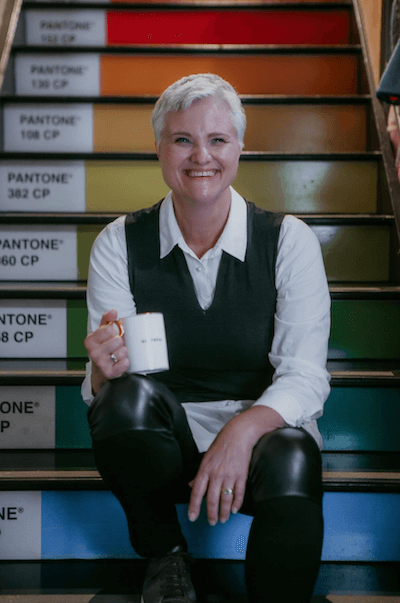Gather ‘round for another story, fabulous health professionals…
After I decided to leave my first marriage, I worked my way into a LOT of consumer debt.
I would simply see things that I wanted and buy them with my credit card. If I liked it, if I wanted it – I bought it.
I was a single mum at the time. I thought I knew how to budget. But really, what I knew how to do was spend. I had felt trapped in this marriage, and leaving it brought with it an incredible sense of relief and freedom. I wanted to feel free and my over-spending was a reflection of that.
Looking back, the interesting thing was that I didn’t make really big purchases — it’s not like I went out and bought a new car (well OK, I did, but that was a tax write-off so that was kinda OK, right?). I just didn’t take the time to think about the seemingly small things that were adding up on a daily basis:
The dinner out, the lunch out, the takeout, the new underwear, the new lip gloss, the new shoes, the maybe we will eat that this week, and the – ohhh look it’s on special!We will get two of those this week.
None of these things are bad. My spending was just out of control and it took 3 years for the cumulative effects of the spending to catch up with me. By this time did I had a mortgage, and a home that needed looking after, a car loan and credit card debt that, with no amount of tweaking, could be serviced by my income at the time.
Suddenly, I had found myself in quite a mess.
The house needed attending to. The flooring, the kitchen, and falling down stairs – they didn’t all happen overnight; they happened in the 5 years I had been living in the house.
The car needed fuel servicing and after three years it needed fundamental (yet annoyingly expensive) things like tyres, breaks pads and other car-like things (hey, I’m not a mechanic) that are required to keep a vehicle safe and on the road.
And with a credit card that lived at its maximum every month, I was only making the required repayments every month (and that even felt like a struggle). It was quite confronting when I read a credit card statement that suggested that It would take me 15 years to pay off this debt paying the minimum amount, and that was if I stopped using the card!
What does this have to do with Private Practice Mastery – or the small things that matter?
Well — none of this debt happened over night. The snowball effect occurred over a few years of doing 1 or 2 things at a time that simply added up.
It’s like weight gain. No one eats 1 big meal and then needs to go and buy new pants. Weight gain is a result of many many many big meals, and more calories than our body can use in a day.
We know that the sustainable way to pay off debt is to strategically pay down a debt while not accumulating more. Consistently, with focused intention. Weight loss is similar, consistently focused intention to change your behaviour will lead to a reduction in weight.
We wish it wasn’t true. But you all know it is, as unsexy as that truth may be.
What we secretly wish was true was that there was some magic pill, some silver bullet, some transformational thing that would make the debt and weight go away overnight. This is so ingrained in our western world psyche. The same thing that makes us want everything we want right now is the reason why we struggle to be consistent with our actions and our progress.
Please: give me the quick, cheap, pain-free solution. Nope, I don’t want to change, I definitely don’t want to feel any discomfort, and yes, I do want everything to stay the same – just to be thinner and feel wealthier. Can you make that happen for me please?
All marketers know this. This is like human behaviour 101 – people want to know that your solution to their biggest pain point will be quick, free, cheap and painless. You’ve met these people as potential clients and guess what – most of us are these people. We’re not all that different, at the end of the day.
The problem is we all want TRANSFORMATION in an instant: the bolt of lightning that comes down from the sky that totally rewires our brain without us having to do anything different. To learn some new hack and technique that will solve all of our problems and pain for us; to make the next thing we want comfortable, enjoyable and so damn good that we’re begging for more.
Want I want to tell you that transformation rarely occurs in an instant.
Transformation is more often than not the result of:
Intentional decision making
· Focus
· Discipline
· Discomfort
· Setbacks
· Failure
· Letting go
· Re-establishing goals
… You get the drift, right?
It’s exactly that same in your Private Practice. We want more revenue, increased profitability, more time, more energy to do more, to be more, to have more – yet we want this with a magic bolt of lightning where it’s all good, all of the time.
You know this already – you will have awesome days, you will have bad days and you will have those kinda in between “meh” days. It’s called life. However how you chose to be on those days is the cumulative effect of your transformation and the tiny decisions you make day in, day out that add up to something big.
What begins as a small advantage — be it a habit change, an attitude change and decision to let something go — will over time create a cumulative effect. And the advantages of this cumulative effect far outweigh what you can possibly achieve with one single silver bullet solution that has no staying power.
Take Olympic athletes. We know that the difference between first and second place in the men’s 100 metre sprint can come down to one 1000th of a second. We had the debacle with the full-body swimming suites for a while, where all the swimmers were wearing their second skins to get that millisecond advantage.
This is really similar to the cumulative effects that are going on in our Practice. It is the difference between those who are “cutting it” and growing and those who are plodding and staying same. It’s the difference between a thriving Practice and lifeless Practice.
Now don’t get me wrong, thriving does not have to mean exponential growth – it also means self-development, it means living your life and doing your work congruently, it means clients are achieving their goals in therapy, it means we are loving the work we do because we are doing it the way we want to do it with the people we want to serve.
However, instead of looking for the next super power, the next hack, sliver-bullet, conference, motivational speaker… what are the small things that you can be doing to help you create a cumulative advantage for yourself?
What are the small things you can do every day that over time will make a massive difference?
Here’s a couple of ideas to get the ideas flowing for you:
1. Only touch that piece of paper once, file everything as it comes across your desk
… And never complain about the need for filing again
2. Write your notes after every client, therefore leaving 15-30 minutes between sessions
… And never have to worry about when you are going to get your notes up to date
3. Drink at least 2L of water every day
… And feel cleaner with your organs being able to function better because you are hydrated
4. Walk while you are talking on the phone
… And feel fitter and more energised because you are moving your body, spreading oxygen to every part of your being.
5. Have a management or planning meeting with key people in your team every week
… And cut down on the email chains, the instant messaging interruptions andthe phone call interruptions.
6. Turn off your email and social media ( believe me no one will die)
… Even if it is for 2 hours a day, imagine what you can get done if you allow no interruptions for just two hours
7. Eat lunch!
… And nourish your body so it is able to do its best for you and your clients.
8. Decide what time you will end work each day and stick to it
… And be home on time, the time you set!
9. Replace 1 hour of TV with 1 hour of Professional Development
… And if you do this for 1 hour a week, that’s 52 hours of personal and or professional development a YEAR!
10. Save 10% of every fee you receive. Not for tax, not for supplies, not for anything but to see wealth being created.
… And if you see 20 clients at $120 each per week, that’s $240 per week, that’s $1000 a month and around $10K per year!
I will also suggest that we need to just choose one thing, and create that as a new habit or change. Of we try and implement too many new things all at once we will sink. Just choose one
What is 1 thing you can commit to, that you know will bring about a massive accumulative change to your Practice and more importantly to you?
Try this quick exercise, and share you answer with me in the comments below:
–> What’s the problem?
–> What makes it a problem?
–> Why is it worth fixing?
–> How will I fix it?
–> What one small step can I take today to move a tiny bit closer towards fixing that problem?
A very wise person once said that success comes in the habits of the every day. And it’s with this sentiment that I’d like to finish our Private Practice Mastery series.
Here’s to your success,
Jo
ABOUT JO
Jo Muirhead is a Rehabilitation Counsellor with over 20 years of experience in vocational rehabilitation, and a mentor to allied health professionals who are ready to make freedom, flexibility and fulfilment happen in 2016 and beyond.
Click here to get the first workbook in the series created exclusively for clinicians in private practice: Why Goal Setting Doesn’t Always Work (and how to make it easier).



